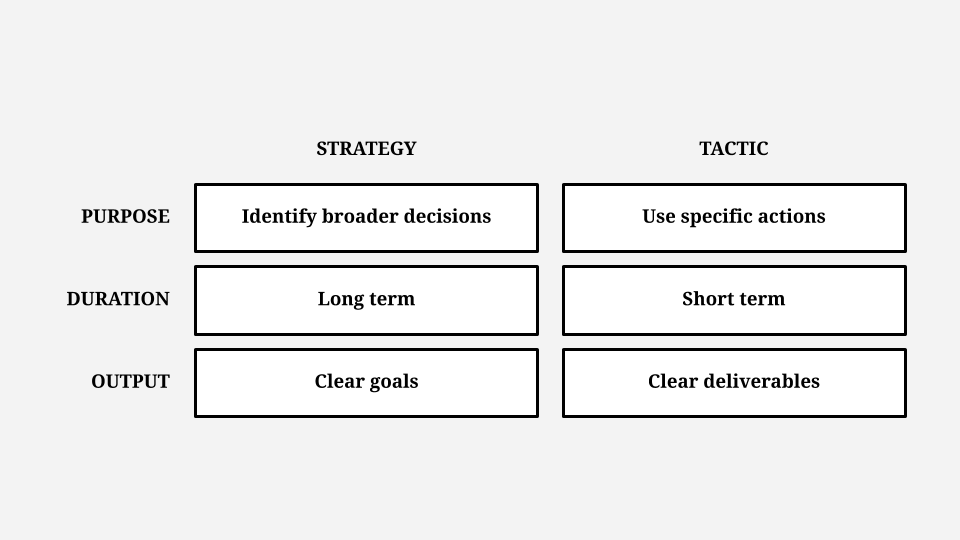You have a plan. It sounds like a good, solid plan. You’ve written it down. You’ve even asked for feedback. You’re ready to execute. Then, down the line, something goes wrong. Despite all your effort and care, the painstakingly crafted strategy doesn’t seem to work. What happened?
The reason why most strategies fail is they’re not actually strategies—they are tactics. The terms strategy and tactic are so intertwined they often get confused. “Strategy without tactics is the slowest route to victory, tactics without strategy is the noise before defeat” wrote Chinese military strategist Sun Tzu in The Art of War about 2,500 years ago. That idiom still rings true today.
The difference between strategy and tactics
Those terms find their origin in military usage. Let’s say the overall objective is to win a war against another nation. The strategy could be to prevent the other country from waging war in the first place by preemptively destroying their military forces. The tactics may include surprise attacks on their military bases.

While strategy is the overall plan, which may involve complex decision-making, tactics are the actual means used to achieve the strategy’s goal. In other words, strategy governs tactical execution. Strategy is the set of decisions used to reach an overall goal, whereas tactics are the actions used when enacting those strategic decisions.
At work, many so-called strategies are actually laundry lists of tactics without an overarching direction. A lack of strategy often results in confusion when specific tactics don’t work the way they were expected to, and a lack of cohesion between the team when it comes to brainstorming new tactics.
“In reality strategy is actually very straightforward. You pick a general direction and implement like hell.”
Jack Welch, former chairman and CEO of General Electric.
The main reasons why most strategies fail
Beside the fact that most strategies are just a bunch of tactics, there are many other reasons why strategies fail. Here is a short list.
- Having a strategy for the sake of it. A strategy feels reassuring. It gives us the illusion of control. It turns a messy process into a seemingly clear, step-by-step recipe for success. But sometimes “giving it a shot” is the best strategy. Increments of curiosity expand your perception of possible. Failing like a scientist, where failure becomes a new data point, can be more valuable than trying to get things right.
- Not including the right people. Strategy should not be just a top-down process. It rarely works when you approach strategy as an exclusive process involving executives, and expect for the rest of the team to blindly implement it.
- Starting too early. I don’t personally believe early stage startups can have a solid strategic plan. Everything is in motion. You don’t know what you don’t know. Designing a strategy can be a way to avoid getting your hands dirty and doing the actual work—the work that may plainly show you that your idea won’t work. So, instead of calling potential customers and doing validation research, we craft a beautiful deck with an elaborate strategy. At the early stages, it’s the wrong way to spend your time. Talk to your customers. Do the work.
- Putting your head in the sand. Related to the previous point, a strategy is also sometimes a way to avoid difficult conversations. “We have a strategy, let’s execute on it.” Because we wrongly think a strategy is set in stone, we ignore the limitations we’ve discovered, the roadblocks we can see ahead, the inherent flaws of the plan. A strategy based on dishonest postulates will crumble at the first adverse event.
- Not seeing it through. Finally, many people craft a strategy and put it on the shelf. May as well not craft a strategy at all. You won’t know if you were right or wrong without executing on the plan. Yes, moving from paper to real-life execution can be scary, but it’s the only way to learn and grow.
Next time you design a strategy, whether at work or for your own business, go through this list and honestly answer this question: do any of these factors apply to my current strategy? Did I design a strategy just for the sake of it? Did I involve the right people? It may feel like a waste of time, but it will take no time at all compared to applying a bunch of tactics masquerading as strategy.
